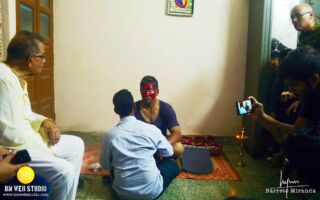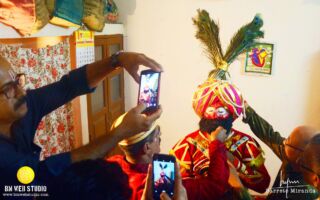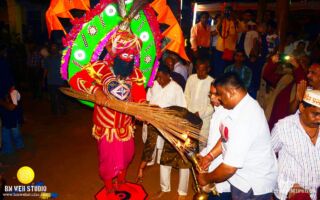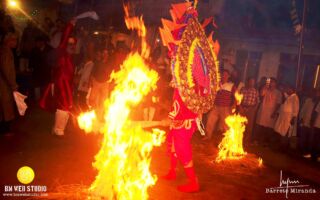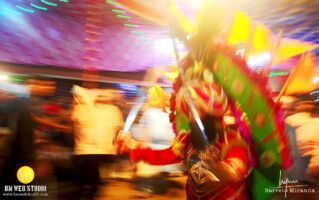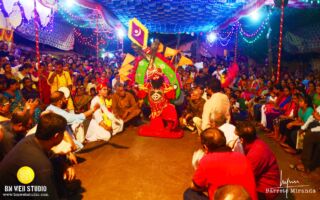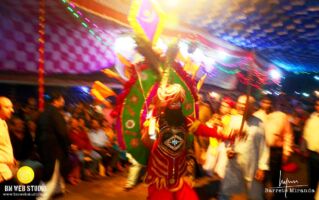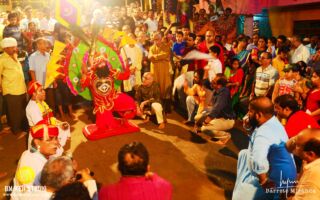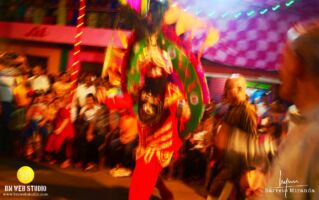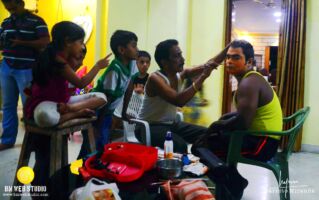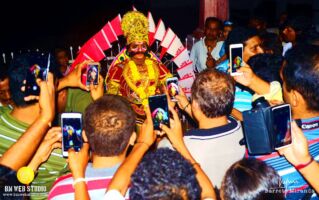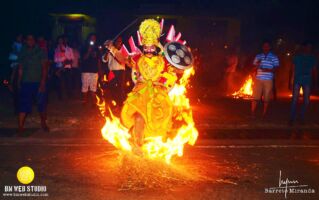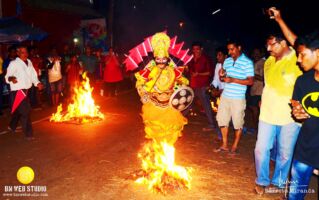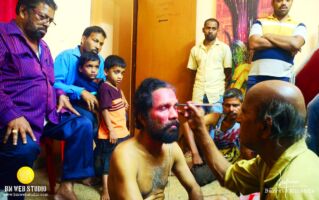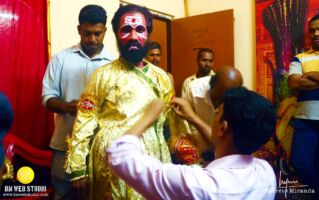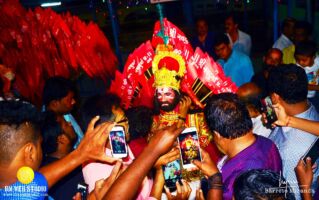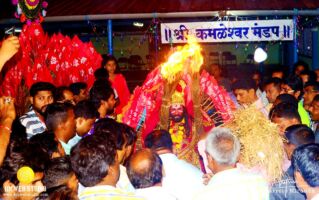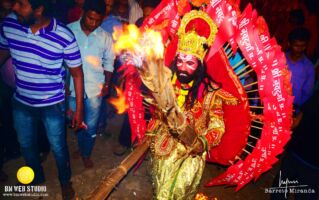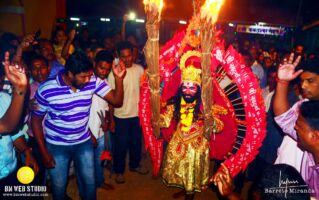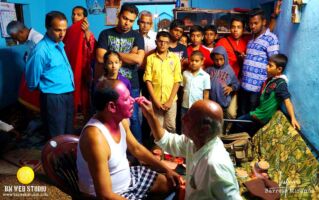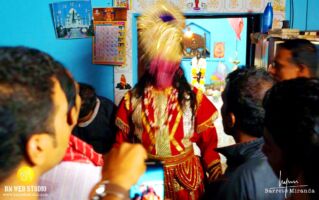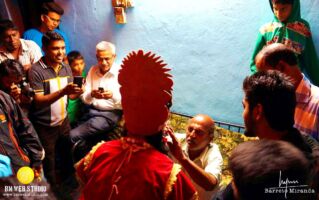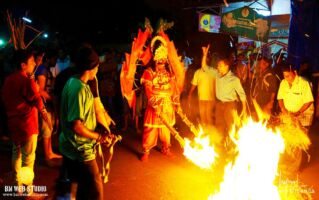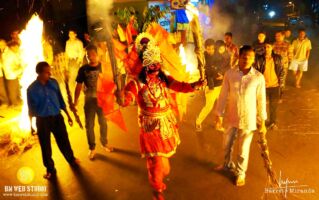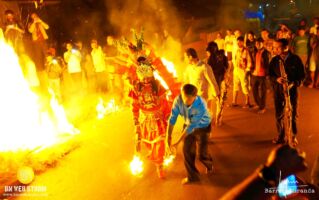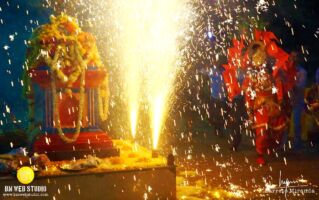Virbhadra folk dance reflects martial arts tradition
Virbhadra at Sanguem
Virbhadra at Shiroda
Virbhadra at Borim
Virbhadra at Ponda
Goa is a land where Lord Shiva is worshipped in varied forms. Virbhadra is one of the attendants of Lord Shiva who is regarded in Goa as one of the sons of Parvati and Lord Shiva. Although there is no temple or a shrine dedicated to Virbhadra in Goa, Virbhadra is respected and a folkdance of Virbhadra is performed in various parts of Goa during different occasions. The cult of Virbhadra worship and Virbhadra folk dance clearly indicates the influence of Karnataka. Even today, while addressing Virbhadra, terms like Kailasvalige, Houdu and Virbhadra Anna, which have their roots in the Kannada language, are used. It is believed that the Virbhadra folk dance was established in Goa during the Vijaynagar empire.
Every year, people in Bicholim, Ponda and Sanguem talukas perform the Virbhadra folkdance.
In Bicholim town, one day before Gudi Padwa, the Hindu New Year day, they perform the Virbhadra folk dance. On the last day of shigmo there is a presentation of Virbhadra in Borde and in Vithalapur near Sanquelim, there is a performance on the last day of Chaitra Utsav i.e the full moon day during the first month of the Hindu calendar. It is believed that Shri Vithal temple of Karapur was established in Vithalapur in 1392 AD. Shri Vithal is a popular form of Lord Vishnu, responsible for promoting the Bhakti cult in Goa, Maharashtra, Karnataka and other parts of the south India. Shri Vithal mainly helped in bridging the gap between the two sects namely Shaivaites and Vaishnavites and that is why Virbhadra dance is performed in the vicinity of Shri Vithal temple near Sanquelim.
Virbhadra folk dance of Vithalapur is the most popular performance in Goa and a large crowd gathers to witness the Virbhadra, which is followed by a chariot procession. To the beats of the dhol (drum), taso (drum) and kasale (cymbals), a folk artist dressed in royal costumes and a cardboard having many small flags tied to him, performs the dance. He also wears a crown on his head, wears long hair and has his face painted to resemble Virbhadra. He holds two swords in his hand as though he is waging a battle and after taking a few rounds, he slips into a trance. His aggressive moods during the performance instill fear and terror in the minds of the audience. Ghodemodni, Virbhadra and Viramel are some of the folk dances which showcase the influence of warfare inherited by the communities.
As per a mythological story, the father of goddess Parvati Daksha had organised a ceremony of sacrifice. All gods and goddesses were invited except Lord Shiva. When Parvati and Lord Shiva went to attend the ceremony, they were publicly insulted by Daksha. Parvati could not tolerate the insult, so she jumped into the burning fire and turned to ashes. Shiva, in anger, created Virbhadra who not only destroyed the sacrificial ceremony but also unleashed a reign of terror. The Virbhadra folk dance is in memory of this incident.
In Ponda, after the performance of Navaro-Vhakal, there is a Virbhadra performance. In other parts of Ponda, the Virbhadra is performed during the Paush, tenth month of the Hindu calendar on the occasion of the eco-feministic festival of dhalo.
In Sanguem, on the day of Gudi Padwa, Virbhadra is performed by a member of the Kosambe family. However, before Virbhadra presentation, a girl dressed as goddess Saraswati rides on an effigy of a peacock and performs the enchanting dance of Saraswati.
The Virbhadra folk dance which is performed in many parts of Goa, reflects the martial arts tradition of the land. Virbhadra, is the representation of a deity associated with the battle field and his performance of dance is said to inspire the warriors.”
Article by Rajendra P Kerkar
Photos by Lynn Barreto Miranda / lynn.barretomiranda.com
Photos of Virbhadra at Sanguem held on 27th Margao 2017
Photos of Virbhadra at Borim held on 4th April 2017
Photos of Virbhadra at Ponda held on 5th April 2017
Photos of Virbhadra at Shiroda held on 12th April 2017
Veerabhadra Dance Goa
The fearsome Veerabhadra, a persona of Lord Shiva is honoured once a year by the people of Goa through song and dance. This warrior style dance is performed by a group of three men, one of whom dons both the garb and persona of Veerabhadra himself and dances fearsomely with two swords. The dance is heavily influenced by the neighbouring state of Karnataka.
The dance is performed in several locations across Goa the main ones being Sanguem, Sanquelim, Ponda Borim and Shiroda.
This dance is mainly performed on Gudi Padwa, which is the Hindu New Year and on the last day of Shigmo, however, in the Bicholim Taluka it is also performed on the last day of the Dhalo festival, which is a festival celebrating the fertility of the earth.
Mythology of Veerabhadra
The daughter of Daksha, Sati was deeply in love with Lord Shiva. However, her father was not a devotee of Shiva and did not want her to marry him. He therefore did not invite Shiva to Sati’s Swayamvara. However Sati refused to garland any of the other suitors, instead throwing her garland in the air and calling upon Shiva to receive it. He acquiesced to her request and appeared in their midst, wearing the garland.
After this, Daksha could not prevent their marriage and Sati accordingly married Shiva. Sometime after their marriage, Daksha made preparations for an important and auspicious horse sacrifice called Dakhsa Yaga. He invited all the gods and goddesses, except Shiva. Sati’s desire to go to her home and meet her parents whom she still loved overcame her sense of etiquette and she went uninvited to the ceremony.
However, when she reached there her father insulted her and berated her and her husband until, no longer able to bear it, she cast herself into the sacrificial fire and died. When Shiva heard of this he was enraged and began to do a fearsome war dance of destruction. Finally, he plucked a lock of hair from his head and cast it to the ground where it writhed and formed into Virabhadra and Rudrakali.
Virabadhra is the fearsome form of Shiva who has eight hands and arms each bearing a different weapon. His skin is dark as the clouds that had formed during the dance of destruction, he had three burning eyes, fiery hair and wore a garland of skulls around his neck.
He marched to make war on Daksha at the bidding of Shiva and to desecrate his Dakhsa Yagna. He broke the sacrificial vessels, polluted the fire, insulted the Brahmin priests, trampled on Indra and broke the staff of Yama.
Lord Vishnu, whose devotee Daksha was could not allow this desecration so he jumped astride his Garuda and began to battle the fearsome Virabhadra. Both of them used their celestial weapons, but neither could gain the upper hand. Their fierce battle left the onlookers awestruck and shook the very foundations of all the three worlds.
Vishnu finally decided to put an end to the chaos by hurling his Sudarshna Chakra which was undefeatable. However, Veerabhadra merely opened his mouth and swallowed the chakra whole. Seeing this Vishnu was awestruck and ceased fighting, rather praising the awesome prowess of his erstwhile opponent. With Vishnu no longer opposing him, Veerabhadra stuck the head off Daksha and then proceeded to Mount Kailash to report the successful completion of his mission.
The Dance of Veerbhadra
The costume of Veerabhadra is both elaborate and extremely heavy. The traditional halo which is attached to the back of the dancer shows influences of the Yakshagana dance of Karnataka and the Theyyam dance of Kerala. The turban is tied in the Mysore style.
The dance is performed to the beat of the talaash and the dholak. It is also accompanied by rhythmic musical syllables which are in the traditional South Indian style, like ‘tha thai ya’ and ‘thak thai ya’. The dance is performed solely by the costumed and painted Veerabhadra, supported on either side by two supporters.
The person who espouses the character of Veerabhadra has several stringent observances that he has to keep prior to the performance of the dance. He is supposed to maintain a strictly vegetarian diet for six days prior to the performance and to fast on the day of the performance.
When the performance begins he is handed two lit chudtis (flaming torches made of coconut leaves) as he dances his way to the mand. The path to the mand is lined by piles of dried grass on either side, and these are set alight with the chudtis. When he reaches the mand, the chudtis are taken away and in their place he holds two swords.
The dance is preceded by almost a dozen rounds of dancing which culminate in the final performance. The person assumes the character of Veerabhadra and falls into a trance, dancing violently and frenziedly. Because of the weight of the costume, there is a high chance of his falling onto his back during the performance. However, since this would be a terrible omen, precautions are taken to see that he is supported on either side.

